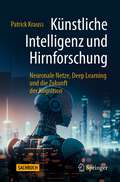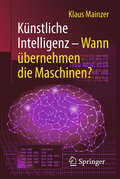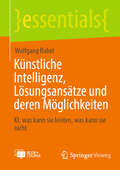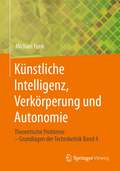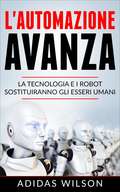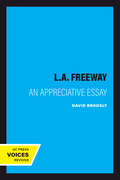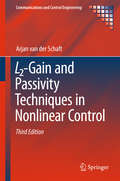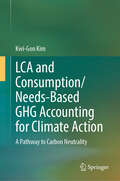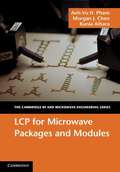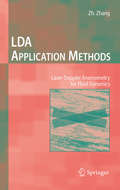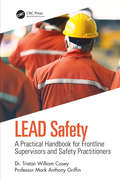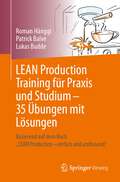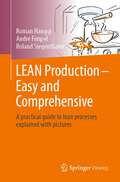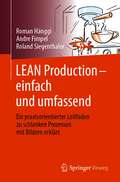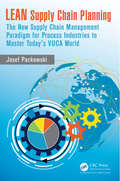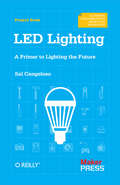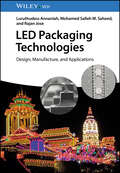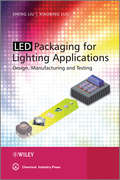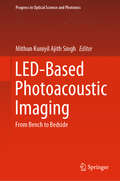- Table View
- List View
Künstliche Intelligenz in der Bildung
by Claudia De Witt Christina Gloerfeld Silke Elisabeth WredeDer Band geht von einer bildungswissenschaftlichen Perspektive auf Künstliche Intelligenz (KI) aus. Er enthält bildungstheoretische Standpunkte zum Einfluss von KI auf Bildung und stellt didaktische Positionen bzw. Gestaltungsansätze von KI in Schule, der beruflichen (Weiter-)Bildung und Hochschulbildung vor. Neben Ansätzen zur Kompetenzentwicklung mit KI in der Bildungspraxis hebt der Band zudem den erklärbaren, ethisch orientierten und souverän beherrschbaren Umgang mit KI hervor.
Künstliche Intelligenz und Hirnforschung: Neuronale Netze, Deep Learning und die Zukunft der Kognition
by Patrick KraussWie funktioniert Künstliche Intelligenz (KI) und gibt es Parallelen zum menschlichen Gehirn? Was sind die Gemeinsamkeiten von natürlicher und künstlicher Intelligenz, und was die Unterschiede? Ist das Gehirn nichts anderes als ein biologischer Computer? Was sind Neuronale Netze und wie kann der Begriff Deep Learning einfach erklärt werden?Seit der kognitiven Revolution Mitte des letzten Jahrhunderts sind KI und Hirnforschung eng miteinander verflochten. Im Bereich der KI gab es in den letzten Jahren mehrere spektakuläre Durchbrüche, von alphaGo über DALL-E 2 bis ChatGPT, die so bis vor kurzem noch völlig undenkbar waren. Doch schon heute arbeiten Forscher an den Innovationen von morgen, wie hybrides maschinelles Lernen oder neuro-symbolische KI. Aber was verbirgt sich dahinter überhaupt?Anhand aktueller Forschungsergebnisse und spannender Beispiele aus der Praxis bietet dieses Sachbuch einen verständlichen Einstieg in die Grundlagen und Herausforderungen dieser faszinierenden Disziplinen. Sie erfahren, was Neurowissenschaft und Psychologie über die Funktionsweise des Gehirns wissen und wie Künstliche Intelligenz arbeitet. Lernen Sie zudem, wie KI unser Verständnis des Gehirns revolutioniert hat und wie Erkenntnisse aus der Hirnforschung umgekehrt in der Informatik eingesetzt werden, um KI-Algorithmen weiterzuentwickeln. Entdecken Sie die faszinierende Welt dieser beiden Disziplinen. Erfahren Sie, warum Künstliche Intelligenz und Hirnforschung zwei Seiten einer Medaille sind und wie sie unsere Zukunft prägen werden.
Künstliche Intelligenz und schlanke Produktion
by Tin-Chih Toly Chen Yi-Chi WangDieses Buch wendet künstliche Intelligenz auf die schlanke Produktion an und zeigt, wie sich die Vorteile dieser beiden Disziplinen praktisch kombinieren lassen. Die schlanke Produktion hat ihren Ursprung in Japan und ist ein bekanntes Instrument zur Verbesserung der Wettbewerbsfähigkeit der Hersteller. Zu den gängigen Werkzeugen der schlanken Produktion gehören Kanban, Pacemaker, Wertstromkarte, 5s, Just-in-Time und Pull Manufacturing. Lean Manufacturing und das Toyota-Produktionssystem wurden in verschiedenen Fabriken und Lieferketten auf der ganzen Welt erfolgreich eingesetzt. Ein schlankes Fertigungssystem kann nicht nur Verschwendung und Lagerbestände reduzieren, sondern auch unmittelbarer auf Kundenbedürfnisse reagieren. Künstliche Intelligenz ist ein Thema, das in letzter Zeit viel Aufmerksamkeit auf sich gezogen hat. Viele Forscher und praktische Entwickler arbeiten hart daran, künstliche Intelligenz in unserem täglichen Leben anzuwenden, auch in Fabriken. So wurden beispielsweise Fuzzy-Regeln zur Optimierung von Maschineneinstellungen entwickelt. Es wurden bionische Algorithmen vorgeschlagen, um Probleme bei der Produktionsreihenfolge und -planung zu lösen. Technologien des maschinellen Lernens werden eingesetzt, um mögliche Probleme mit der Produktqualität zu erkennen und den Zustand einer Maschine zu diagnostizieren. Dieses Buch ist für Produktionsingenieure, Manager sowie für Studenten und Forscher im Bereich der Fertigungstechnik von Interesse.
Künstliche Intelligenz – Wann übernehmen die Maschinen?
by Klaus MainzerJeder kennt sie. Smartphones, die mit uns sprechen, Armbanduhren, die unsere Gesundheitsdaten aufzeichnen, Arbeitsabläufe, die sich automatisch organisieren, Autos, Flugzeuge und Drohnen, die sich selber steuern, Verkehrs- und Energiesysteme mit autonomer Logistik oder Roboter, die ferne Planeten erkunden, sind technische Beispiele einer vernetzten Welt intelligenter Systeme. Machine Learning verändert unsere Zivilisation dramatisch. Wir verlassen uns immer mehr auf effiziente Algorithmen, weil die Komplexität unserer zivilisatorischen Infrastruktur sonst nicht zu bewältigen ist. Aber wie sicher sind KI-Algorithmen? Diese Herausforderung wird in der 2.Auflage aufgegriffen: Komplexe neuronale Netze werden mit riesigen Datenmengen (Big Data) gefüttert und trainiert. Die Anzahl der dazu notwenigen Parameter explodiert exponentiell. Niemand weiß genau, was sich in diesen „Black Boxes“ im Einzelnen abspielt. Im Machine Learning benötigen wir mehr Erklärung (explainability) und Zurechnung (accountability) von Ursachen und Wirkungen, um ethische und rechtliche Fragen der Verantwortung (z.B. beim autonomen Fahren oder in der Medizin) entscheiden zu können! Seit ihrer Entstehung ist die KI-Forschung mit großen Visionen über die Zukunft der Menschheit verbunden. Sie ist bereits eine Schlüsseltechnologie, die den globalen Wettstreit der Gesellschaftssysteme entscheiden wird. „Künstliche Intelligenz und Verantwortung“ ist eine weitere zentrale Ergänzung der 2. Auflage: Wie sollen wir unsere individuellen Freiheitsrechte in der KI-Welt sichern? Dieses Buch ist ein Plädoyer für Technikgestaltung: KI muss sich als Dienstleistung in der Gesellschaft bewähren.
Künstliche Intelligenz, Lösungsansätze und deren Möglichkeiten: KI, was kann sie leisten, was kann sie nicht (essentials)
by Wolfgang BabelKünstliche Intelligenz (KI), Künstliche Neuronale Netzwerke (KNN) sind heute in aller Munde und hängen auch unmittelbar miteinander zusammen. Besonders KI und KNN werden oftmals in einem Atemzug genannt. Alles wird in den Medien heute als künstliche Intelligenz verkauft. Das geht von Raumfahrttechnik, autonomen Fahren, Spracherkennung, Übersetzungen bis hinunter zum Kaffeeautomaten. Künstliche Intelligenz weckt heute unnötig Ängste, In den letzten Monaten häufen sich Warnungen vor den potenziellen Gefahren von KI. Es wird der KI nachgesagt, dass sie so gefährlich wie ein Atomkrieg. Außerdem KI nimmt Arbeitsplätze weg. All diese Statements werden aufgegriffen, dargestellt und erläutert. Es wird versucht die Gegebenheiten sachlich darzustellen und die Ängste abzubauen. Den kostenlosen Zugang zum Online-Kurs finden Sie direkt im Buch.
Künstliche Intelligenz, Verkörperung und Autonomie: Theoretische Probleme – Grundlagen der Technikethik Band 4
by Michael FunkWas wissen Maschinen? Können sie wirklich mit uns sprechen? Haben sie Bewusstsein? Was ist gemeint, wenn Roboter als „verkörperte KI“ oder als „autonom“ bezeichnet werden? Vorliegendes Buch stellt sich diesen und weiteren Fragen. Denn Technikethik ist eng mit theoretischen Herausforderungen verbunden. Vor diesem Hintergrund wird in die Erkenntnislehre, Sprachanalyse, Körper-Geist-Verhältnisse sowie die Philosophie des Geistes systematisch eingeführt. Manches, das wir Maschinen vorschnell zuschreiben, entpuppt sich bei genauer Betrachtung als Schein. Warum ist das so? Mit Beispielen, Tabellen und Übersichten werden Antworten eingängig und strukturiert erarbeitet. Das Buch richtet sich an Ingenieurwissenschaftler*innen, Informatiker*innen und Geisteswissenschaftler*innen im Berufsalltag, aber auch an interessierte Lai*innen, die Möglichkeiten und Grenzen der KI kritisch hinterfragen wollen. Es bildet den vierten, in sich abgerundeten Teil der Buchreihe Grundlagen der Technikethik.Haben Maschinen den Geist, den wir brauchen, und brauchen wir den Geist, in dem wir Maschinen designen?
Künstliche Intelligenz: Wie verändert sich unsere Zukunft?
by Arnold KitzmannKünstliche Intelligenz (KI) durchdringt zunehmend unser gesamtes Leben, angefangen bei den hochwillkommenen kleinen Erleichterungen des Alltags bis hin zu gravierenden gesellschaftlichen Veränderungen in Arbeitswelt, Forschung und Entwicklung sowie der Privatsphäre jedes Einzelnen. Wir können uns dieser Entwicklung nicht (mehr) entziehen oder gar verweigern, sondern sind gefordert, uns mit ihr auseinanderzusetzen. Dieses Buch erörtert philosophische, ethische, politische, ökonomische Aspekte ebenso wie die Problematik der Selbstbestimmtheit, Freiheit und Manipulierbarkeit des Einzelnen. So entsteht ein kleiner Leitfaden für den Leser, um sich selbst in dieser Phase großer gesellschaftlicher Umwälzungen zu positionieren. Last not least spannend: In der Auseinandersetzung mit Künstlicher Intelligenz wird klar, dass sie uns Heutigen mit Fragen konfrontiert, die bereits die Philosophie vor über zweieinhalb Jahrtausenden umtrieb.
Künstliche neuronale Netzwerke zur adaptiven Fahrdynamikregelung (AutoUni – Schriftenreihe #171)
by Jonas KasteIn dem vorliegenden Buch wird der Einsatz eines hybriden Regelungskonzeptes für die Fahrdynamikregelung eines autonomen Versuchsträgers untersucht. Dabei wird ein modellbasierter, kaskadierter Querdynamikregler um ein künstliches neuronales Netzwerk (KNN) erweitert. Das KNN wird ohne „Vorwissen“ implementiert und aktiv im geschlossenen Regelkreis trainiert. Die Untersuchungen werden dabei sowohl in Simulationen, als auch in einem realen Versuchsträger durchgeführt. Die Versuche zeigen das Leistungsvermögen des hybriden Regelungskonzeptes. Bei geringer Fahrzeugdynamik ist eine präzise Fahrzeugführung auch ohne KNN möglich. Bei hoher Dynamik resultieren jedoch Abweichungen vom Sollkurs, die durch das iterativ lernende Netzwerk schrittweise reduziert werden. Durch die situationsabhängige Optimierung der Netzwerkgewichte wird der Einfluss des systematischen Fehlers des zu Grunde liegenden Modells kompensiert und die Regelgüte verbessert. Dieses Verhalten kann durch geeignete Auswahl der Designparameter des KNN für jedes der betrachteten Szenarien aufgezeigt werden. Die Anpassung der Netzwerkgewichte ermöglicht sowohl im Fehlerfall als auch bei hoher Fahrzeugdynamik und ungenauer Systemidentifikation eine Verbesserung der Regelgüte im Vergleich zum rein modellbasierten Basisregler.
L'automazione avanza: la tecnologia e i robot sostituiranno gli esseri umani
by Adidas WilsonProbabilmente un'idea dell'influenza negativa che i robot avranno sul lavoro umano ce l'avete già. I protagonisti del mondo tecnologico, come Bill Gates ed Elon Musk, hanno proposto delle soluzioni: imposta universale sul reddito o robot tax. Ma, tra seri avvertimenti e utopie fantascientifiche, sembra che ci si dimentichi del dolore umano che deriverà dalla futura perdita del lavoro. Tra circa 15 anni l'economia statunitense perderà il 38% dei posti di lavoro a causa dell'automazione. È un dato allarmante. Eppure, molti ritengono che l'automazione non debba e non possa rallentare. Ma perché non frenare un po' questo processo? Solo di quel tanto che consentirebbe di allinearlo alle tendenze di slow fashion e slow food. Quanto meno dovremmo riconsiderare la proprietà degli autocarri a guida autonoma. La robotizzazione non sarebbe così dannosa, se fossero i camionisti a possedere gli autocarri a guida autonoma, invece delle aziende che li possiedono tutti. Al momento, la robotizzazione è una minaccia reale e rappresenta un pericolo per le infrastrutture umane fondamentali.
L.A. Freeway: An Appreciative Essay
by David BrodslyThis title is part of UC Press's Voices Revived program, which commemorates University of California Press’s mission to seek out and cultivate the brightest minds and give them voice, reach, and impact. Drawing on a backlist dating to 1893, Voices Revived makes high-quality, peer-reviewed scholarship accessible once again using print-on-demand technology. This title was originally published in 1981.
L2-Gain and Passivity Techniques in Nonlinear Control
by Arjan SchaftThis standard text gives a unified treatment of passivity and L2-gain theory for nonlinear state space systems, preceded by a compact treatment of classical passivity and small-gain theorems for nonlinear input-output maps. The synthesis between passivity and L2-gain theory is provided by the theory of dissipative systems. Specifically, the small-gain and passivity theorems and their implications for nonlinear stability and stabilization are discussed from this standpoint. The connection between L2-gain and passivity via scattering is detailed. Feedback equivalence to a passive system and resulting stabilization strategies are discussed. The passivity concepts are enriched by a generalised Hamiltonian formalism, emphasising the close relations with physical modeling and control by interconnection, and leading to novel control methodologies going beyond passivity. The potential of L2-gain techniques in nonlinear control, including a theory of all-pass factorizations of nonlinear systems, and of parametrization of stabilizing controllers, is demonstrated. The nonlinear H-infinity optimal control problem is also treated and the book concludes with a geometric analysis of the solution sets of Hamilton-Jacobi inequalities and their relation with Riccati inequalities for the linearization. #65533; L2-Gain and Passivity Techniques in Nonlinear Control (third edition) is thoroughly updated, revised, reorganized and expanded. Among the changes, readers will find: #65533; updated and extended coverage of dissipative systems theory #65533; substantial new material regarding converse passivity theorems and incremental/shifted passivity #65533; coverage of recent developments on networks of passive systems with examples #65533; a completely overhauled and succinct introduction to modeling and control of port-Hamiltonian systems, followed by an exposition of port-Hamiltonian formulation of physical network dynamics #65533; updated treatment of all-pass factorization of nonlinear systems The book provides graduate students and researchers in systems and control with a compact presentation of a fundamental and rapidly developing area of nonlinear control theory, illustrated by a broad range of relevant examples stemming from different application areas.
LA MOTIVATION DANS LE CADRE PROFESSIONNEL: LE CAS PROCTER ET GAMBLE
by Gabriele NapolitanoLe sujet de la motivation dans le cadre professionnel est un sujet de plus en plus important pour les travailleurs, mais également pour les entreprises elles-mêmes. Cette thèse nait de l'intérêt envers les opérations concrètes qui peuvent mener à une amélioration de la motivation personnelle et non pas envers les diverses théories motivationelles existantes. C'est pour cette raison que j'ai décidé d'analyser le comportement d'une entreprise de pointe dans son secteur, celui des biens de consommation, qui est également l'une des entreprises les plus importantes et influentes au niveau mondial : Procter & Gamble. Nous verrons donc quel type de conséquences résultent de sa politique et de ses initiatives concernant la motivation du personnel, en insistant tout particulièrement sur les concepts de Promote from within et Diversity and Inclusion.
LCA and Consumption/Needs-Based GHG Accounting for Climate Action: A Pathway to Carbon Neutrality
by Kwi-Gon KimThis book reveals causes of the GHG emission accounting practice failure over the last several decades, describes evolution of new tenets of the accounting and remaining tasks, and suggests a new comprehensive integrated accounting in the form of protocol. The latest Intergovernmental Panel on Climate Change (IPCC) assessment report calls for net zero CO2 emissions by 2050 to limit warming to 1.5 degree C. As a result, many countries, cities, and industries are putting forward their greenhouse gas (GHG) emission reduction actions and commitments. But can the countries, cities, and industries meet these ambitious decarbonization goals without a reliable GHG inventory? This book tries to answer this question. It has been argued that there is a need to include LCA and consumption/needs-based GHG emissions as a complimentary indicator to the current approach of production-based GHG accounting emissions. As a shifting of the focus of accounting system after the Paris Agreement, consumption/needs-based approach is newly focused on a more broader accounting approach for NDCs and LDCs with a vision of all of society approach. Traditional national inventory approach to GHG emission accounting has been severely criticized as being too production process-oriented, sector-based approach, less transparent, a lack of public participation, no considerations for human needs and human factors.
LCP for Microwave Packages and Modules
by Morgan J. Chen Kunia Aihara Anh-Vu H. PhamA comprehensive overview of electrical design using Liquid Crystal Polymer (LCP), giving you everything you need to know to get up-to-speed on the subject. This text describes successful design and development techniques for high-performance microwave and millimeter-wave packages and modules in an organic platform. These were specifically developed to make the most of LCP's inert, hermetic, low-cost, high-frequency (DC to 110+ GHz) properties. First-hand accounts show you how to avoid various pitfalls during design and development. You'll get extensive electrical design details in areas of broadband circuit design for low-loss interconnects, couplers, splitters/combiners, baluns, phase shifters, time-delay units (TDU), power amplifier (PA) modules, receiver modules, phased-array antennas, flexible electronics, surface mounted packages, Microelectromechanical Systems (MEMS) and reliability. Ideal for engineers in the fields of RF, microwave, signal integrity, advanced packaging, material science, optical and biomedical engineering.
LDA Application Methods
by Zhengji ZhangThis technical book considers the application side of LDA techniques. Starting from the basic theories that are crucial for each LDA user, the main subject of the book is focused on diverse application methods. In details, it deals with universal methodical techniques that have been mostly developed in the last 15 years. The book thus gives for the first time an application reference for LDA users in improving the optical conditions and enhancing the measurement accuracies. It also provides the guidelines for simplifying the measurements and correcting measurement errors as well as for clarifying the application limits and extending the application areas of LDA techniques. Beside the treatments of some traditional optical and flow mechanical features influencing the measurement accuracies, the book shows a broad spectrum of LDA application methods in the manner of measuring the flow turbulence, resolving the secondary flow structures, and quantifying the optical aberrations at measurements of internal flows etc.. Thus, it also supports the further developments of both the hard- and software of LDA instrumentations.
LEAD Safety: A Practical Handbook for Frontline Supervisors and Safety Practitioners
by Tristan William Casey Mark Anthony GriffinLEAD Safety concentrates on self-development and education in safety leadership. It takes safety leadership in an exciting new direction, with practical tools that will give organisations the skills they need to make a difference in their safety program. The book provides a non-technical overview of safety leadership and outlines the core skills safety managers should demonstrate and practice. Organisations will see improvements in engagement, morale, trust, and motivation in the workplace. Readers will gain an appreciation of a new and evidence-based safety leadership model, as well as formulate a personalized action plan to improve safety in their workplace.
LEAN Production Training für Praxis und Studium – 35 Übungen mit Lösungen: Basierend auf dem Buch „LEAN Production – einfach und umfassend“
by Roman Hänggi Lukas Budde Patrick BalveKeine Produktion ist perfekt. In jedem Prozess schleicht sich Verschwendung ein. Sie macht ihn langsam und teuer. Ware liegt im Lager herum, die Fertigung findet in unnötig großen Losen statt oder Mitarbeiter warten unproduktiv, um ein nächstes Teil zu produzieren. Das Ergebnis sind hohe Produktionskosten und enttäuschte Kunden.Lean Production geht nun diese Verschwendungen in allen Prozessen an. Aber wie setzt man nun die verschiedensten Lean Prinzipien und Methoden konkret um? Der Erfolg von Lean Production liegt jedoch im Tun und gerade da setzt das Buch an. Die 35 Übungen aus der Praxis zeigen detailliert auf, wie die Lean Ansätze angewendet und erfolgreich umgesetzt werden. Die Lösungen werden mit Praxis-Tipps zur Umsetzung aus der umfassenden Erfahrung der Autoren ergänzt. Die Übungen werden in der LeanClean AG anschaulich mit vielen Bildern und Diagrammen umgesetzt – konkret, einfach undumfassend erklärt.
LEAN Production – Easy and Comprehensive: A practical guide to lean processes explained with pictures
by Roman Hänggi André Fimpel Roland SiegenthalerNo production is perfect. Waste always creeps into the processes, makes them slow, sluggish and expensive. Parts and material pile up in the warehouse, production takes place in unnecessarily large batches, transport is taking time, employees wait unproductively for their next task or products ship too late. The result is high production costs and disappointed customers.The Lean movement has set itself the goal of uncovering waste, question it and eliminate it.This book will explain in a simple and comprehensive way the Lean principles as well as the practical tools to make production processes as lean and value-added as possible. Because we all love stories, each method is entertainingly wrapped in an illustrated story. In this book, a barista who has to run marathon distances every day, the cup Tim struggles with overproduction and the LeanClean Inc. counts on your support to trim the vacuum cleaner production to maximum value creation with value stream mapping, spaghetti diagram, 5S or Kanban. For each topic, you will find our practical tips. They are the lessons learned from our Lean projects over the past 20 years in many countries. They will help you to implement your Lean initiatives even more effectively and successfully.
LEAN Production – einfach und umfassend: Ein praxisorientierter Leitfaden zu schlanken Prozessen mit Bildern erklärt
by Roman Hänggi André Fimpel Roland SiegenthalerKeine Produktion ist perfekt. Im Prozess schleicht sich stets Verschwendung ein, macht ihn langsam, träge und teuer. Ware liegt im Lager herum, die Fertigung findet in unnötig großen Losen statt, Transporte sind erforderlich oder Mitarbeiter warten unproduktiv, um ein nächstes Teil einzuspannen. Das Ergebnis sind hohe Produktionskosten und enttäuschte Kunden.Die Lean-Bewegung hat sich zum Ziel gesetzt Verschwendung aufzudecken, sie zu hinterfragen und zu beseitigen. Dieses Buch vermittelt dir die theoretischen Grundlagen, aber auch die praktischen Werkzeuge, um Produktionsprozesse so schlank und wertschöpfend wie möglich zu gestalten. Weil wir alle Geschichten lieben ist jede Methode unterhaltsam in eine Story verpackt. In diesem Buch lebt ein Barista der täglich Marathondistanzen laufen muss, der Tassen-Tim kämpft mit Überproduktion und die LeanClean AG zählt auf deine Unterstützung, um mit Wertstromanalyse, Spaghetti-Diagramm, 5S oder Kanban die Staubsaugerproduktion auf maximale Wertschöpfung zu trimmen. Zu jedem Thema gibt's unsere Praxis-Tipps. Sie sind die Erkenntnis aus unseren Lean-Projekten der vergangenen 20 Jahre. Sie werden dir helfen, deine Lean-Initiativen noch effektiver und erfolgreicher umzusetzen.
LEAN Supply Chain Planning: The New Supply Chain Management Paradigm for Process Industries to Master Today's VUCA World
by Josef PackowskiDelivering excellent service to all customers is the key imperative for many sustainable businesses. So why do so many supply chains struggle to fulfill customer requirements at competitive costs? The answer is simple: traditional supply chain planning, which was tailored to a predominantly stable and predictable business environment, cannot handle
LED Lighting for Urban Agriculture
by Toyoki Kozai Kazuhiro Fujiwara Erik S. RunkleThis book focuses on light-emitting diode (LED) lighting, mainly for the commercial production of horticultural crops in plant factories and greenhouses with controlled environments, giving special attention to: 1) plant growth and development as affected by the light environment; and 2) business and technological opportunities and challenges with regard to LEDs. The book contains more than 30 chapters grouped into seven parts: 1) overview of controlled-environment agriculture and its significance; 2) the effects of ambient light on plant growth and development; 3) optical and physiological characteristics of plant leaves and canopies; 4) greenhouse crop production with supplemental LED lighting; 5) effects of light quality on plant physiology and morphology; 6) current status of commercial plant factories under LED lighting; and 7) basics of LEDs and LED lighting for plant cultivation. LED lighting for urban agriculture in the forthcoming decades will not be just an advanced form of current urban agriculture. It will be largely based on two fields: One is a new paradigm and rapidly advancing concepts, global technologies for LEDs, information and communication technology, renewable energy, and related expertise and their methodologies; the other is basic science and technology that should not change for the next several decades. Consideration should be given now to future urban agriculture based on those two fields. The tremendous potentials of LED lighting for urban agriculture are stimulating many people in various fields including researchers, businesspeople, policy makers, educators, students, community developers, architects, designers, and entrepreneurs. Readers of this book will understand the principle, concept, design, operation, social roles, pros and cons, costs and benefits of LED lighting for urban agriculture, and its possibilities and challenges for solving local as well as global agricultural, environmental, and social issues.
LED Lighting: A Primer to Lighting the Future
by Sal CangelosoWe’re on the brink of a lighting revolution with light-emitting diodes—the tiny LEDs you’ve seen in electronic devices for years. With this practical guide, you’ll go behind the scenes to see how and why manufacturers are now designing LED devices to light everything from homes and offices to streets and warehouses.Author Sal Cangeloso shows you the working parts of a “simple” LED bulb and explains the challenges electronics companies face as they push LED lighting into the mainstream. You’ll learn how you can use LEDs now, and why solid state lighting will bring dramatic changes in the near future.Explore the drivers, phosphors, and integrated circuits in a typical LED bulbUnderstand the challenges in producing LED bulbs with acceptable brightness, color temperature, and power consumptionLearn about non-bulb LED applications, including lamps, street lights, and signageDiscover the market forces driving—and impeding—the adoption of LED lightingCompare LEDs to compact fluorescent lamps (CFLs) and electron-stimulated luminescence (ESL) bulbsGaze into the future of intelligent lighting, including networked lighting systems
LED Packaging Technologies: Design, Manufacture, and Applications
by Rajan Jose Luruthudass Annaniah Mohamed Salleh SaheedLED Packaging Technologies Up-to-date practitioner’s guide on LED packaging technologies, with application examples from relevant industries, historical insight, and outlook LED Packaging Technologies provides expert insight into current and future trends in LED packaging technologies, discussing the fundamentals of LED packaging technologies, from electrical contact design, thermal management and optical emission, and extraction, to manufacturing technologies, including the JEDEC testing standards, followed by accounts on the main applications of these LED packages in the automotive, consumer electronics, and lighting industries. LED Packaging Technologies includes information on: History of primitive lighting in human civilization to the invention of modern LEDs based lighting, and historic evolution of LED packaging technology Basic light emission and extraction technology in LED packages, covering package design impacting light emission and extraction Medical industry applications of LEDs, especially in healthcare treatments, such as in skin rejuvenation and wound healing and closures Quantum confinement phenomena and size-dependent optical properties of quantum dots, and the advancement of future quantum dot LEDs Covering the fundamentals, design, and manufacturing of LED packaging technology and assisting in removing some of the barriers in the development of LED packaging and new applications, LED Packaging Technologies is an essential source of information for engineers in the LED and lighting industries, as well as researchers in academia.
LED Packaging for Lighting Applications: Design, Manufacturing, and Testing
by Sheng Liu Xiaobing LuoSince the first light-emitting diode (LED) was invented by Holonyak and Bevacqua in 1962, LEDs have made remarkable progress in the past few decades with the rapid development of epitaxy growth, chip design and manufacture, packaging structure, processes, and packaging materials. LEDs have superior characteristics such as high efficiency, small size, long life, low power consumption, and high reliability. The market for white LED is growing rapidly in various applications. It has been widely accepted that white LEDs will be the fourth illumination source to substitute the incandescent, fluorescent, and high-pressure sodium lamps. With the development of LED chip and packaging technologies, the efficiency of high power white LED will broaden the application markets of LEDs while changing the lighting concepts of our lives. In LED Packaging for Lighting Applications, Professors Liu and Luo cover the full spectrum of design, manufacturing, and testing. Many concepts are proposed for the first time, and readers will benefit from the concurrent engineering and co-design approaches to advanced engineering design of LED products. One of the only books to cover LEDs from package design to manufacturing to testing Focuses on the design of LED packaging and its applications such as road lights Includes design methods and experiences necessary for LED engineers, especially optical and thermal design Introduces novel LED packaging structures and manufacturing processes, such as ASLP Covers reliability considerations, the most challenging problem for the LED industry Provides measurement and testing standards, which are critical for LED development, for both LED and LED fixtures Codes and demonstrations available from the book’s Companion Website This book is ideal for practicing engineers working in design or packaging at LED companies and graduate students preparing for work in industry. This book also provides a helpful introduction for advanced undergraduates, graduates, researchers, lighting designers, and product managers interested in the fundamentals of LED design and production. Color version of selected figures can be found at www.wiley.com/go/liu/led
LED-Based Photoacoustic Imaging: From Bench to Bedside (Progress in Optical Science and Photonics #7)
by Mithun Kuniyil Ajith SinghThis book highlights the use of LEDs in biomedical photoacoustic imaging. In chapters written by key opinion leaders in the field, it covers a broad range of topics, including fundamentals, principles, instrumentation, image reconstruction and data/image processing methods, preclinical and clinical applications of LED-based photoacoustic imaging. Apart from preclinical imaging studies and early clinical pilot studies using LED-based photoacoustics, the book includes a chapter exploring the opportunities and challenges of clinical translation from an industry perspective. Given its scope, the book will appeal to scientists and engineers in academia and industry, as well as medical experts interested in the clinical applications of photoacoustic imaging.

